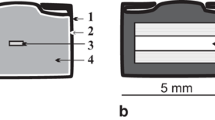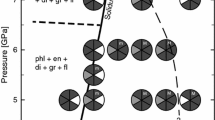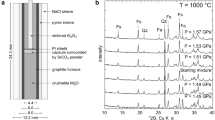Summary
The phase relations of K-richterite, KNaCaMg5Si8O22(OH)2, and phlogopite, K3Mg6 Al2Si6O20(OH)2, have been investigated at pressures of 5–15 GPa and temperatures of 1000–1500 °C. K-richterite is stable to about 1450 °C at 9–10 GPa, where the dp/dT-slope of the decomposition curve changes from positive to negative. At 1000 °C the alkali-rich, low-Al amphibole is stable to more than 14 GPa. Phlogopite has a more limited stability range with a maximum thermal stability limit of 1350 °C at 4–5 GPa and a pressure stability limit of 9–10 GPa at 1000 °C. The high-pressure decomposition reactions for both of the phases produce relatively small amounts of highly alkaline water-dominated fluids, in combination with mineral assemblages that are relatively close to the decomposing hydrous phase in bulk composition. In contrast, the incongruent melting of K-richterite and phlogopite in the 1–3 GPa range involves a larger proportion of hydrous silicate melts.
The K-richterite breakdown produces high-Ca pyroxene and orthoenstatite or clinoenstatite at all pressures above 4 GPa. At higher pressures additional phases are: wadeite-structured K2SiVISiIV 3O9 at 10 GPa and 1500 °C, wadeite-structured K2SiVISiIV 3O9 and phase X at 15 GPa and 1500 °C, and stishovite at 15 GPa and 1100 °C. The solid breakdown phases of phlogopite are dominated by pyrope and forsterite. At 9–10 GPa and 1100–1400 °C phase X is an additional phase, partly accompanied by clinoenstatite close to the decomposition curve. Phase X has variable composition. In the KCMSH-system (K2CaMg5Si8O22(OH)2) investigated by Inoue et al. (1998) and in the KMASH-system investigated in this report the compositions are approximately K4Mg8Si8O25(OH)2 and K3.7Mg7.4Al0.6Si8.0O25(OH)2, respectively.
Observations from natural compositions and from the phlogopite-diopside system indicate that phlogopite-clinopyroxene assemblages are stable along common geothermal gradients (including subduction zones) to 8–9 GPa and are replaced by K-richterite at higher pressures. The stability relations of the pure end member phases of K-richterite and phlogopite are consistent with these observations, suggesting that K-richterite may be stable into the mantle transition zone, at least along colder slab geotherms. The breakdown of moderate proportions of K-richterite in peridotite in the upper part of the transition zone may be accompanied by the formation of the potassic and hydrous phase X. Additional hydrogen released by this breakdown may dissolve in wadsleyite. Therefore, very small amounts of hydrous fluids may be released during such a decomposition.
Similar content being viewed by others
Author information
Authors and Affiliations
Additional information
Received April 10, 2000; revised version accepted November 6, 2000
Rights and permissions
About this article
Cite this article
Trønnes, R. Stability range and decomposition of potassic richterite and phlogopite end members at 5–15 GPa. Mineralogy and Petrology 74, 129–148 (2002). https://doi.org/10.1007/s007100200001
Issue Date:
DOI: https://doi.org/10.1007/s007100200001




